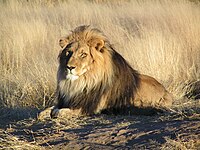
Photo from wikipedia
Abstract To examine the variation of multiple predator effects and functional response caused by interaction of conspecific predators under different prey density, we established swimming crab, Portunus trituberculatus - Manila… Click to show full abstract
Abstract To examine the variation of multiple predator effects and functional response caused by interaction of conspecific predators under different prey density, we established swimming crab, Portunus trituberculatus - Manila clam, Ruditapes philippinarum foraging systems in the laboratory. Specifically, we quantified predation rate, foraging behaviors, and encounter behaviors between predators under different clam density treatments. The main results were as follows: (1) The effect of clam densities on the fighting between the crab individuals leading to the changes of multiple predator effects type. Independent multiple predator effects were observed in double predator treatments under lower clam density treatments (4–8 clams 0.48 m−2). Non-independent multiple predator effects that would reduce the success rate of predator and the prey risk, occurred in double predator treatments under higher clam density treatments (10–25 clams 0.48 m−2). (2) The probability of fighting upon encounter in high clam density treatments were higher than that in low clam density treatments, and it further reduced the probability of capture upon encounter and increased the probability of consumption upon capture. In low clam density treatments, the foraging behaviors of the crabs were not significantly altered in the presence of competitor. (3) The presence of conspecific competitor did not change the type of functional response, while reducing the magnitude of it. The present study provides a foundation for future research on the relationship between predators interaction and prey population dynamic, which can be used to improve the production of crab or clam aquaculture systems.
Journal Title: Aquaculture
Year Published: 2018
Link to full text (if available)
Share on Social Media: Sign Up to like & get
recommendations!